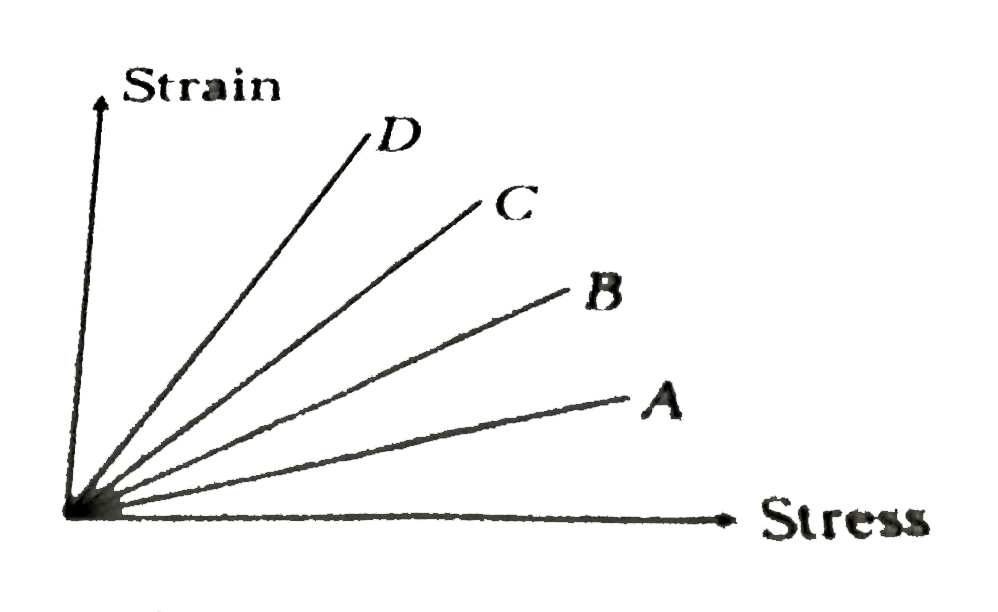The temperature of a wire is doubled. The Young's modulus of elasticity
also double
become four times
remain same
decrease.
The correct Answer is:D
To solve the problem regarding the effect of doubling the temperature on the Young's modulus of elasticity, we can follow these steps:
1. Understanding Young's Modulus:
Young's modulus (Y) is defined as the ratio of stress (force per unit area) to strain (deformation per unit length) in a material. Mathematically, it is expressed as:
Y=StressStrain=F/AΔL/L
where F is the force applied, A is the cross-sectional area, ΔL is the change in length, and L is the original length.
2. Effect of Temperature on Length:
When the temperature of a wire increases, it expands. The change in length (ΔL) due to temperature change can be expressed as:
ΔL=αLΔT
where α is the coefficient of linear expansion and ΔT is the change in temperature.
3. Relating Strain to Temperature:
The strain (ΔLL) can be rewritten using the equation for change in length:
ΔLL=αΔT
4. Substituting into Young's Modulus:
Substituting the expression for strain into the equation for Young's modulus gives:
Y=F/AαΔT
5. Analyzing the Effect of Doubling Temperature:
If the initial temperature is T1 and it is doubled to 2T1, the change in temperature (ΔT) will also increase. Since Young's modulus is inversely proportional to the temperature change (as seen from the equation Y∝1ΔT), we can conclude that:
- As temperature increases, Young's modulus decreases.
6. Conclusion:
Therefore, when the temperature is doubled, the Young's modulus of elasticity decreases.
Final Answer:
The Young's modulus of elasticity decreases when the temperature of the wire is doubled. The correct option is D.
Young's modulus (Y) is defined as the ratio of stress (force per unit area) to strain (deformation per unit length) in a material. Mathematically, it is expressed as:
Y=StressStrain=F/AΔL/L
where F is the force applied, A is the cross-sectional area, ΔL is the change in length, and L is the original length.
When the temperature of a wire increases, it expands. The change in length (ΔL) due to temperature change can be expressed as:
ΔL=αLΔT
where α is the coefficient of linear expansion and ΔT is the change in temperature.
The strain (ΔLL) can be rewritten using the equation for change in length:
ΔLL=αΔT
Substituting the expression for strain into the equation for Young's modulus gives:
Y=F/AαΔT
If the initial temperature is T1 and it is doubled to 2T1, the change in temperature (ΔT) will also increase. Since Young's modulus is inversely proportional to the temperature change (as seen from the equation Y∝1ΔT), we can conclude that:
- As temperature increases, Young's modulus decreases.
Therefore, when the temperature is doubled, the Young's modulus of elasticity decreases.
The Young's modulus of elasticity decreases when the temperature of the wire is doubled. The correct option is D.
Topper's Solved these Questions
- BOOK - NCERT FINGERTPS ENGLISHCHAPTER - MECHANICAL PROPERTIES OF SOLIDSEXERCISE - CORNER15videos
MECHANICAL PROPERTIES OF SOLIDS
- BOOK - NCERT FINGERTPS ENGLISHCHAPTER - MECHANICAL PROPERTIES OF SOLIDSEXERCISE - Hooke'S Law3videos
MECHANICAL PROPERTIES OF SOLIDS
- BOOK - NCERT FINGERTPS ENGLISHCHAPTER - MECHANICAL PROPERTIES OF SOLIDSEXERCISE - HOTS8videos
MECHANICAL PROPERTIES OF SOLIDS
- BOOK - NCERT FINGERTPS ENGLISHCHAPTER - MECHANICAL PROPERTIES OF FLUIDSEXERCISE - NCERT Exemplar5videos
MECHANICAL PROPERTIES OF FLUIDS
- BOOK - NCERT FINGERTPS ENGLISHCHAPTER - MOTION IN A PLANE EXERCISE - Assertion And Reason15videos
MOTION IN A PLANE
Similar Questions
Assertion: From the relation Y =FlAΔl, we can say that, if length of a wire is doubled, its young's modulus of elasticity will also becomes two times.
Reason : Modulus of elasticity is a material property.View Solutionisobaric modulus of elasticity is
View SolutionAssertion If length of a wire is halved, its Young's modulus of elasticity will become two times.
Reason The ratio of longitudinal stress and longitudinal strain is called Young's modulus of elasticity.View SolutionStress-strain curve for four metals are shown in figure. The maximum Young's modulus of elasticity is for metal
 View Solution
View SolutionA steel wire is stretched by 1kgwt. If the radius of the wire is doubled, its Young's modulus will
View SolutionYoung modulus of elasticity for a gas is
View SolutionA bar of mass m and length l is hanging from point A as shown in the figure . If the Young's modulus of elasticity of the bar is Y and area of cross - section of the wire is A, then the increase in its length due to its own weight will be
 View Solution
View SolutionAssertion Bulk modulus of elasticity of gases is pressure dependent.
Reason More the pressure of gas, more is the Bulk modulus of elasticity of gas.View SolutionAssertion The materials having low value of Young's modulus of elasticity are more ductile.
Reason If Young's modulus is less, they can be easily stretched as wires.View SolutionA metallic wire of length l is held between two rigid supports. If the wire is cooled through a temperature t. (Y= Young's modulus of elasticity of wire, ρ= density, α= thermal coefficient of linear expansion). Then the frequency of oscillation is proportional to
View Solution

